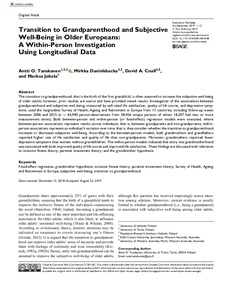Transition to Grandparenthood and Subjective Well-Being in Older Europeans: A Within-Person Investigation Using Longitudinal Data
Danielsbacka M; Tanskanen AO; Jokela M; Coall DA
Transition to Grandparenthood and Subjective Well-Being in Older Europeans: A Within-Person Investigation Using Longitudinal Data
Danielsbacka M
Tanskanen AO
Jokela M
Coall DA
SAGE PUBLICATIONS INC
Julkaisun pysyvä osoite on:
https://urn.fi/URN:NBN:fi-fe2021042820817
https://urn.fi/URN:NBN:fi-fe2021042820817
Tiivistelmä
The transition to grandparenthood, that is the birth of the first grandchild, is often assumed to increase the subjective well-being of older adults; however, prior studies are scarce and have provided mixed results. Investigation of the associations between grandparenthood and subjective well-being, measured by self-rated life satisfaction, quality of life scores, and depressive symptoms, used the longitudinal Survey of Health, Ageing and Retirement in Europe from 13 countries, including follow-up waves between 2006 and 2015 (n = 64,940 person-observations from 38,456 unique persons of whom 18,207 had two or more measurement times). Both between-person and within-person (or fixed-effect) regression models were executed, where between-person associations represent results across individuals, that is, between grandparents and non-grandparents; within-person associations represent an individual's variation over time, that is, they consider whether the transition to grandparenthood increases or decreases subjective well-being. According to the between-person models, both grandmothers and grandfathers reported higher rate of life satisfaction and quality of life than non-grandparents. Moreover, grandmothers reported fewer depressive symptoms than women without grandchildren. The within-person models indicated that entry into grandmotherhood was associated with both improved quality of life scores and improved life satisfaction. These findings are discussed with reference to inclusive fitness theory, parental investment theory, and the grandmother hypothesis.
Kokoelmat
- Rinnakkaistallenteet [19207]
